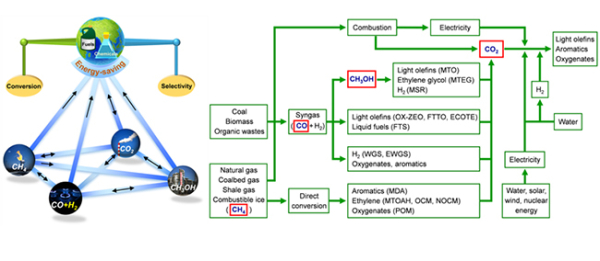by: Dalian Institute of Chemical Physics, Chinese Academy of Sciences
Deng Dehui, a researcher at the State Key Laboratory of Catalysis, the Dalian Institute of Chemical Physics, Chinese Academy of Sciences, and Bao Xinhe, an academician of the Chinese Academy of Sciences, have attracted the attention of colleagues at home and abroad for their research on the catalytic conversion of C1 molecules. Recently, the team was invited to publish a forward-looking article entitled Catalysis for Selected C1 Chemistry.
The gradual consumption of global stone resources has brought about increasingly severe environmental pollution problems. It is particularly important to find ways to low carbon emissions and efficiently convert C1 molecules (CH4, CO2, CO, CH3OH, etc.) into fuels or high-value chemicals. However, due to the large differences in chemical properties of C1 molecules, such as CH4 and CO2 are relatively inert; CH3OH, CO, etc. are relatively active, and there are certain limitations in terms of balance conversion and selectivity. At present, the industrial C1 conversion process has problems such as high energy consumption, multiple steps, and complex product separation processes. Therefore, it is an urgent and extremely challenging subject to explore the directed transformation technology of C1 molecules under mild conditions.
The article systematically reviews the latest progress and important achievements of the research team and international counterparts in the conversion of C1 molecules in the past ten years, with special attention to new catalytic reaction processes, including thermal catalysis, electrocatalysis, photocatalytic conversion processes under mild conditions, and many It can couple catalytic conversion processes, etc., and discuss the key challenges of C1 catalytic chemistry and future development directions.
Deng Dehui and Bao Xinhe's team are committed to the research work of the catalytic conversion of C1 molecules and have made a series of progress, including room temperature oxidation of methane to oxygenates (Chem, 2018, 4, 1902), room temperature electrochemical water-gas conversion to high purity hydrogen (Nat. Commun., 2019, 10, 86), electrocatalytic CO reduction to ethylene (Angew. Chem. Int. Ed., 2020, 59, 154), electrocatalytic CO2 reduction to CO (Angew. Chem. Int. Ed., 2018 , 57,16339), visible light-driven direct methanol to ethylene glycol (Nat. Commun., 2018, 9,1181), etc., provide an important reference for the exploration of new C1 chemical catalysis processes and new systems.
Related research results were published in "Chem" . The research work is funded by the key research and development plan of the Ministry of Science and Technology, the major project of the National Natural Science Foundation, the key research project of the frontier science of the Chinese Academy of Sciences, and the cooperation fund of the Institute of Clean Energy Innovation of the Chinese Academy of Sciences.

Source: http://www.cas.cn/syky/202009/t20200925_4761245.shtml
Disclaimer: This article is translated by cpolymer. The translation is for reference only. All contents are subject to the original text.